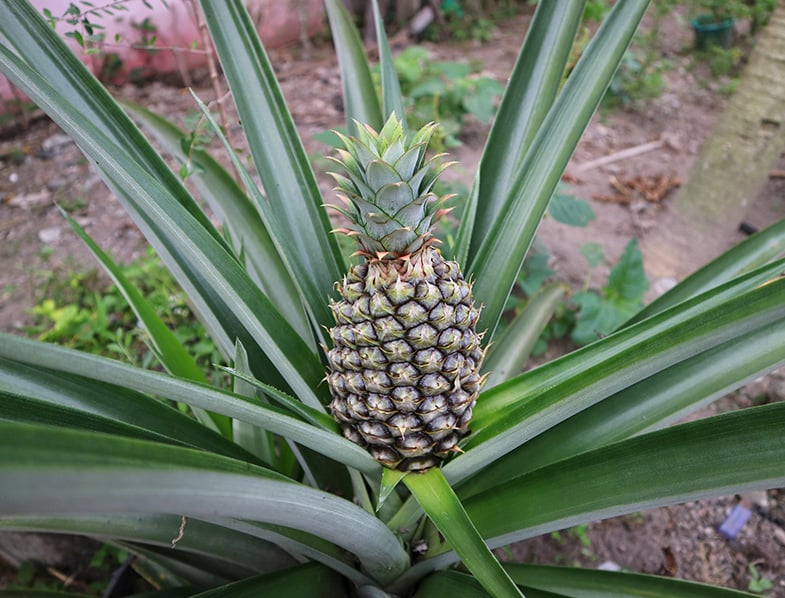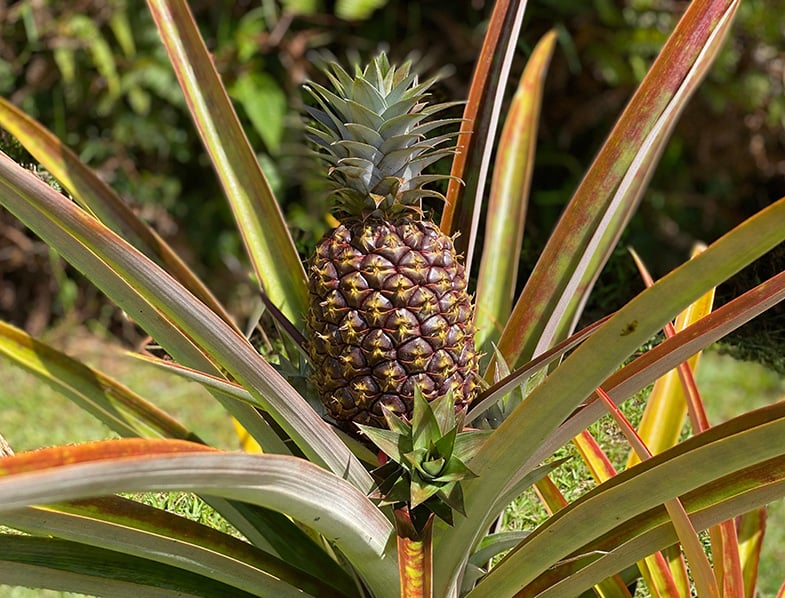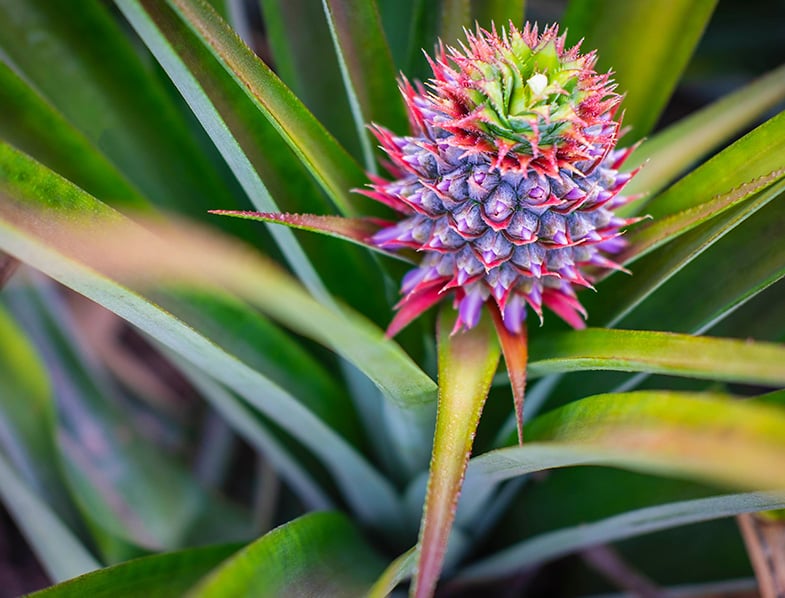Pineapple plants are tropical plants that have become very popular as houseplants. They are easy to grow and can be quite rewarding, as the fruits are not only delicious but also visually stunning. In this complete guide, we will discuss everything you need to know to grow and care for pineapple plants.
Quick Facts
| Topic | Detail |
|---|---|
| Native to | South America |
| Family | Bromeliaceae |
| Plant Type | Herbaceous Perennial |
| Growth Time | 18-24 Months |
| Pollination | Cross-pollination required |
| Varieties | Smooth Cayenne, Queen, Red Spanish |
| Soil pH | 4.5 to 6.5 |
| Watering | Once a week or when soil feels dry |
| Fertilizing | Once every two months with a balanced fertilizer |
| Pruning | Minimal, remove dead or yellowing leaves |
| Common Pests | Mealybugs, scale insects, spider mites, caterpillars, snails |
| Diseases | Root rot, stem rot, leaf spot diseases |
| Prevention | Good drainage, avoid overwatering, use insecticidal soap or neem oil for pests, remove affected parts for diseases, use fungicide |
Understanding Pineapple Plants
Pineapple plants are fascinating herbaceous perennials that belong to the Bromeliaceae family. They are native to South America, but are now grown in tropical regions all over the world. Pineapple plants are not only delicious, but they are also visually stunning. They have a rosette of long, sword-shaped leaves that can grow up to 3 feet long. The leaves are green, with spiky margins and a waxy surface that helps the plant retain moisture. The plant’s fruit grows from the center of the rosette and is surrounded by a crown of leaves.
The Anatomy of a Pineapple Plant
The leaves of a pineapple plant are not only beautiful, but they also serve an important purpose. They are the site of photosynthesis, which is the process by which plants convert sunlight into energy. The leaves also help to protect the plant from predators and harsh weather conditions. The waxy surface of the leaves helps to prevent water loss and protects the plant from harmful UV rays.
The fruit of a pineapple plant is also incredibly unique. The pineapple fruit is actually a multiple fruit, which means that it is made up of many individual flowers that have fused together. Each of these flowers produces a small fruit that fuses with other fruits to form a single large fruit, the pineapple. The pineapple fruit is covered in a tough, spiky skin that protects the sweet and juicy flesh inside.
The Pineapple Plant Life Cycle
Understanding the life cycle of a pineapple plant is essential for successful cultivation. Pineapple plants typically take 18 to 24 months to mature and produce fruit. They are self-incompatible, which means that they need cross-pollination to produce fruit. The plant produces a single inflorescence that can contain up to 200 small flowers. These flowers are pollinated by birds or insects, and each flower produces a small fruit that fuses with other fruits to form a single large fruit, the pineapple.
Once the pineapple fruit has matured, it is ready to be harvested. Pineapple plants are typically harvested when the fruit is fully mature, but not yet ripe. This is because pineapples do not continue to ripen once they have been harvested. Once harvested, the pineapple fruit can be stored for several weeks before it begins to spoil.
Pineapple plants are fascinating and unique plants that are not only delicious, but also visually stunning. Understanding the anatomy and life cycle of a pineapple plant is essential for successful cultivation and appreciation of this tropical fruit. So next time you enjoy a juicy slice of pineapple, take a moment to appreciate the complexity and beauty of the plant that produced it.

Choosing the Right Pineapple Plant Variety
Pineapple is a tropical fruit that is loved by many for its sweet and tangy taste. Growing your pineapple plant is a fun and rewarding experience, but it is essential to choose the right variety for your climate and space. In this article, we will discuss the most common pineapple plant varieties and factors to consider when choosing the right one for you.
Common Pineapple Plant Varieties
There are several varieties of pineapple plants, but the most commonly grown are the Smooth Cayenne, the Queen, and the Red Spanish.
The Smooth Cayenne is the most popular variety and is known for its large and sweet fruit. It has a low acidity level, making it perfect for eating fresh or using in recipes. This variety is also resistant to disease and pests, making it easier to grow for beginners.
The Queen variety has smaller fruit, but it is more flavorful. It has a higher acidity level, which makes it perfect for making pineapple juice or using in cooking. This variety is also more tolerant of colder temperatures, making it suitable for growing in cooler climates.
The Red Spanish is common in warmer regions and has a highly acidic fruit. It is known for its bright red skin and sweet and tangy taste. This variety is also resistant to disease and pests, making it easier to grow for beginners.
Factors to Consider When Choosing a Variety
When choosing your pineapple plant variety, it is essential to consider your climate, available space, and personal preferences.
If you live in a colder climate, the Queen variety may be a better choice for you, as it is more tolerant of colder temperatures. However, if you live in a warmer region, the Red Spanish may be a better choice for you, as it thrives in tropical conditions.
If you have limited space, the Smooth Cayenne may be a better choice for you, as it is more compact than other varieties and can be grown indoors. However, if you have ample space, the Queen or Red Spanish may be a better choice for you, as they produce larger fruit.
Consider the fruit’s flavor, texture, and size when selecting your variety. If you prefer a sweeter and larger fruit, the Smooth Cayenne may be the right choice for you. However, if you prefer a more acidic and flavorful fruit, the Queen or Red Spanish may be a better choice for you.
Choosing the right pineapple plant variety is essential for a successful and enjoyable growing experience. Consider your climate, available space, and personal preferences when selecting your variety, and you will be on your way to growing delicious and juicy pineapples.
Planting Your Pineapple Plant
When to Plant Pineapple Plants
Pineapple plants are a tropical fruit that can add a unique touch to any garden. They can be grown from seeds, but this method is not recommended as it takes several years to produce fruit. The most common method of growing pineapple plants is through planting stem cuttings or the crowns of mature plants. Pineapple plants can be planted year-round, but it is best to plant them in early spring or late summer when temperatures are mild.
Planting your pineapple plant during these times will give it the best chance of thriving. The mild temperatures will allow the plant to establish its roots without being stressed by extreme heat or cold.
Preparing the Soil
Pineapple plants require well-draining soil with a pH of 4.5 to 6.5. The soil should be rich in organic matter and have good drainage. If your soil lacks nutrients, you can add compost or fertilizer before planting. Pineapple plants also prefer slightly acidic soil, so you may need to adjust the pH level if your soil is too alkaline.
It is important to prepare the soil properly before planting your pineapple plant. This will ensure that the plant has the necessary nutrients and drainage to grow properly. Adding compost or fertilizer can help to enrich the soil and provide the plant with the nutrients it needs to thrive. Adjusting the pH level can also be beneficial, as pineapple plants prefer slightly acidic soil.
Planting Techniques for Pineapple Plants
To plant your pineapple crown, remove the lower leaves and cut the crown from the fruit, leaving a small portion of the fruit attached. Let the crown dry for a few days before planting. Dig a hole in the prepared soil and plant the crown with the fruit portion sticking out of the soil. Water the plant thoroughly and keep the soil moist but not waterlogged.
When planting your pineapple plant, it is important to use proper techniques to ensure its success. Removing the lower leaves and letting the crown dry before planting can help to prevent rot and disease. Planting the crown with the fruit portion sticking out of the soil will allow it to root properly and establish itself in the soil. Keeping the soil moist but not waterlogged will help to prevent overwatering and root rot.
With proper planting techniques and care, your pineapple plant can thrive and produce delicious fruit for years to come.

Caring for Your Pineapple Plant
Pineapple plants are a beautiful addition to any home, and with proper care, they can thrive and produce delicious fruit. In this guide, we will discuss the watering requirements, fertilizing needs, and maintenance tips for your pineapple plant.
Watering Requirements
Watering your pineapple plant is essential for its growth and health. However, it’s crucial not to overwater it, as this can cause root rot. It’s recommended to water the plant deeply once a week, or when the soil feels dry. During the winter months, you can reduce the frequency of watering, but make sure not to let the soil dry out completely.
It’s worth noting that pineapple plants also benefit from high humidity levels. You can mist them regularly or place a tray of water near the plant to increase humidity levels.
Fertilizing Your Pineapple Plant
Fertilizing your pineapple plant is crucial to ensure it produces fruit. You should fertilize the plant once every two months with a balanced fertilizer that is high in nitrogen, phosphorus, and potassium. Adding compost or organic matter to the soil can also improve its nutrient content.
Pruning and Maintenance
Pineapple plants require minimal pruning, but it’s essential to remove dead or yellowing leaves to promote healthy growth. The plant will produce suckers or offshoots that can be left to grow into new plants or removed to encourage the main plant’s growth. If you want to reduce the plant’s footprint, you can train it to grow on a trellis or support.
Caring for your pineapple plant is relatively easy if you follow these simple tips. With proper watering, fertilizing, and maintenance, you can enjoy the beauty and delicious fruit of your pineapple plant for years to come.
Pest and Disease Management
Pineapple plants are not only delicious but also easy to care for. They require minimal maintenance and are relatively pest-free. However, like all plants, they can still be susceptible to pests and diseases. In this section, we will discuss some common pests and diseases that can affect your pineapple plant and how to manage them.
Common Pineapple Plant Pests
Mealybugs, scale insects, and spider mites are the most common pests that can affect your pineapple plant. These pests can cause damage to the leaves and fruit of your plant. Mealybugs are small, white, and fuzzy insects that suck the sap from the plant, causing it to weaken and wilt. Scale insects are small, hard-shelled insects that attach themselves to the plant and feed on its sap. Spider mites are tiny, spider-like creatures that can cause yellowing and browning of the leaves.
Fortunately, these pests can be controlled with insecticidal soap or neem oil. Insecticidal soap is a natural and effective way to control pests without harming your plant. Neem oil is also a natural pesticide that can be used to control pests. Both of these products can be found at your local garden center or online.
Caterpillars and snails can also be a problem for your pineapple plant. They can cause damage to the leaves and fruit, which can lead to a decrease in yield. Hand-picking them is the most effective way to control them. You can also use a natural pesticide, such as Bacillus thuringiensis (Bt), to control caterpillars.
Preventing and Treating Pineapple Plant Diseases
Pineapple plants are susceptible to several diseases, including root rot, stem rot, and leaf spot diseases. These diseases are caused by overwatering, poor drainage, and high humidity levels.
To prevent these diseases, ensure that your plant has good drainage. Pineapple plants prefer well-draining soil that is slightly acidic. If your plant is in a pot, make sure that there are drainage holes in the bottom of the pot. Avoid overwatering your plant, as this can lead to root rot. Water your plant only when the top inch of soil is dry.
If your plant does develop a disease, remove the affected parts immediately. This will prevent the disease from spreading to other parts of the plant. Treat the plant with a fungicide to control the disease. Copper fungicides are effective against most fungal diseases that can affect your pineapple plant.
Pest and disease management is an important aspect of caring for your pineapple plant. By following the tips outlined in this section, you can ensure that your plant remains healthy and productive.

Conclusion
Growing pineapple plants can be a fun and rewarding experience. With the right care and attention, your plant will produce juicy and delicious fruit that is sure to impress your friends and family. Remember to choose the right variety for your needs, plant it in well-draining soil, and provide it with sufficient water and nutrients. Keep an eye out for pests and diseases and take prompt action to prevent them from spreading. With these tips, you are well on your way to becoming a successful pineapple plant grower!
Pineapple Plant FAQS
How long does it take to grow a pineapple plant?
The growth time for a pineapple plant typically ranges between 18 and 24 months from planting until it bears fruit.
What is the best way to grow a pineapple plant?
The best way to grow a pineapple plant is usually from stem cuttings or the crowns of mature plants. They should be planted in well-draining soil with a pH of 4.5 to 6.5. The plant should be watered once a week or when the soil feels dry, and fertilized once every two months with a balanced fertilizer.
Do pineapple plants come back every year?
Pineapple plants are perennial, meaning they can live for several years. However, after the plant has produced fruit, its energy goes into producing offshoots, or “suckers”, which can be grown into new plants.
Do pineapple plants need full sun?
Yes, pineapple plants thrive in full sunlight. They need a minimum of six hours of bright light each day. However, they can also tolerate partial shade.
How hard is it to keep a pineapple plant alive?
Keeping a pineapple plant alive is not overly difficult with the right care. They need well-drained soil, sufficient sunlight, and proper watering and fertilizing. Pineapple plants also require minimal pruning. If these conditions are met, the plants are quite resilient.
Can you grow pineapples indoors?
Yes, pineapples can be grown indoors as long as they have enough sunlight. They should be placed near a sunny window where they will get at least six hours of sunlight each day. If adequate natural light is not available, a grow light can also be used.
